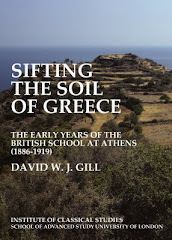In the period up to the outbreak of the First World War BSA students were involved in archaeological work ranging from Sicily to Syria, from Tripolitania and Egypt to Macedonia (and beyond). Their focus was well beyond mainland Greece, the Aegean islands, and Crete.
Is there a major difference between official BSA archaeological projects and other work supported by students? For example, the excavations of the Cyprus Exploration Fund were directed by Ernest Gardner; and even when archaeological work on the island was taken over by the British Museum, BSA Students took part in the excavations and sometimes even directed (Francis B. Welch). The Asia Minor Exploration Fund, established before the BSA, accommodated BSA students from David Hogarth to the work on Roman colonies by G.L. Cheesman.
The BSA was associated with formal excavations at Megalopolis, Phylakopi on Melos, and at Sparta, as well as less ambitious work at Kynosarges. At the same time exploratory work was conducted at Cyzicus, and it had been hoped to open a site in Lycia, at Datcha or Colophon.
The archaeological impact of the BSA went far beyond the Aegean. It covered the Bronze Age but also firmly embraced Roman remains in Anatolia, Byzantine architecture, and even medieval castles in the Levant.
The A.G. Francis Collection
6 days ago






No comments:
Post a Comment